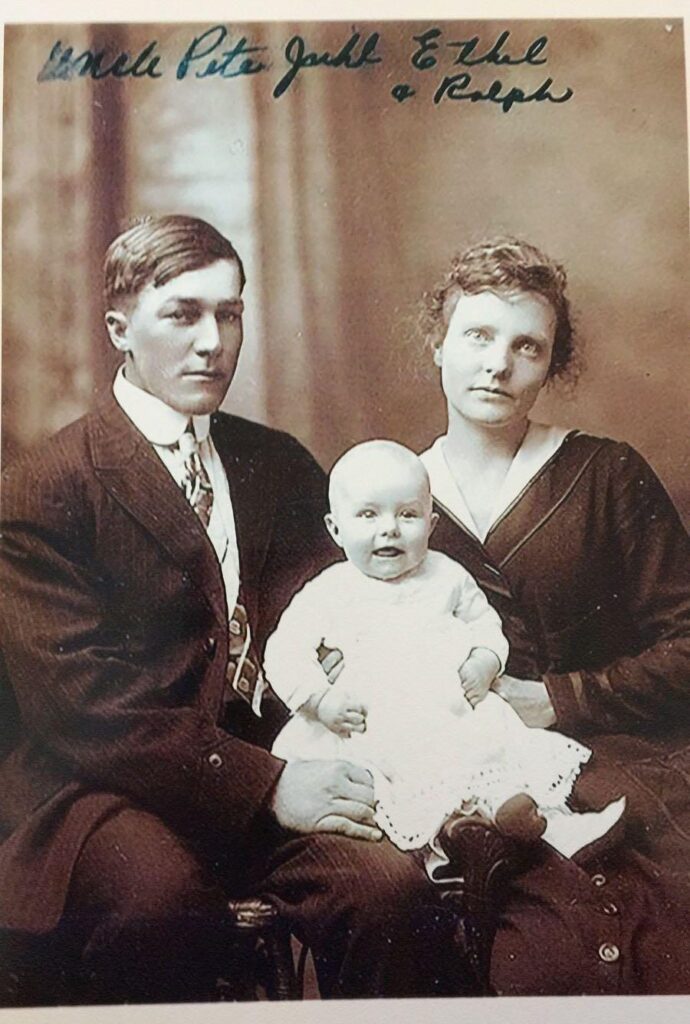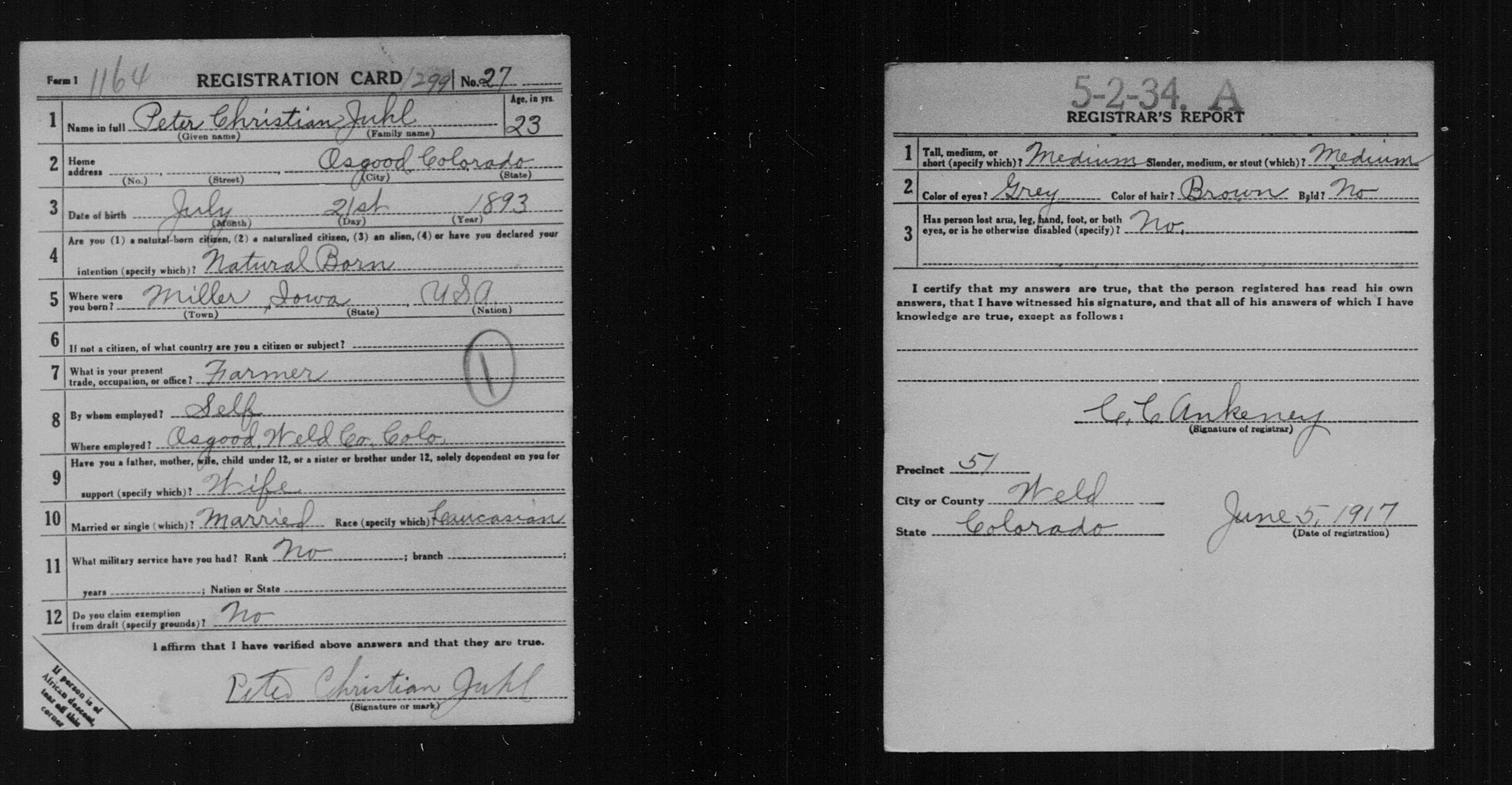The is a snapshot of one of my four great-grandfathers in 1917-1918. I wrote it upon my discovery online of their WWI draft registration cards.
The others, in order of father’s father’s father to mother’s mother’s father, are:
- Post-368: Great-grandfather No.1 [FFF] before draft board, 1917 (this post)
- Post-369: Great-grandfather No.2 [FMF] before draft board, 1917
- Post-370: Great-grandfather No.3 [MFF] before draft board, 1917
- Post-371: Great-grandfather No.4 [MMF] before draft board, 1917
I transcribe the cards below and provide some comments on how the war period turned out for each man. I think I can re-create, with a degree of reliability, a lot of what they were like and how they would have likely stood on the war. Some things I do not know and will pose them as questions. While I never knew any of them, I did now their children in their old age (my grandparents).
A native of Iowa; Farmer; Danish ancestry dating to the 1880s. this card was submitted when he appeared before the Weld County, Colorado, draft board as mandated by law:
Registration Card
1. Name: Peter Christian J—
2. Home Address: Osgood, Colorado
3. Date of Birth: 1893
4. Citizenship: Natural-Born [U.S. citizen]
5. Where were you born? Miller, Iowa, USA
6. If not a citizen, of what country are you a citizen or subject? [No response; not applicable]
7. Occupation: Farmer
8[a]. By whom employed? Self
8[b]. Where employed? Osgood, Weld Co., Colorado
9. Dependents: Wife
10. Married or single? Married
11. What military service have you had? No
12. Do you claim exemption from draft? No“I affirm that I have verified above answers and that they are true,”
[Signed,] Peter Christian J—.
Registrar’s Report
1[a]. Tall, Medium, or Short? Medium
1[b]. Slender, Medium, or Stout? Medium
2[a]. Color or Eyes: Grey
2[b]. Color of Hair: Brown
2[c]. Bald? No
3. […]Disabled? No
I certify that my answers are true, that the person registered has read his own answers, that I have witnessed his signature, and that all of his answers of which I have knowledge are true, except as follows: [blank].
[Signed by the registrar for Precint 57, Weld County, Colorado]
Date of Registration: June 5, 1917

Peter C. J— [1893-1979] was not drafted and did not serve in World War I.
Why was Peter C. not drafted? What was going in his life in the 1910s? What was his (likely) position on the 1914-1918 war? I think I can offer insights into these things as follows:
Peter C. had a strong exemption: “Registrants employed in agricultural labor,” and a lesser exemption: “Married registrants with dependent spouse.” He had no children yet in 1917, but my grandfather was born the next year.
Though Peter C. was not drafted, I recall my grandfather saying that his father (i.e., Peter C.) had a cousin of the same first and last name, and of the same approximate age, with the only way to tell them apart being their differing middle initials (the cousin Peter S.). Peter S. was drafted but Peter C. was not.
One might be tempted to imagine a case of same-name mistaken identity letting my great-grandfather off the hook: [Draft Board official on selection day:] “Okay, next one. Oh, that name again? We already took him this morning; Say, who’s in charge here, anyway? Who allowed the same name to come up twice? Shred that duplicate card, please. Next name, and no more duplicates!” This improbable situation is made impossible by the fact that Peter C. and Peter S. were in different states at the time (Colorado and Iowa, respectively).
What was going on in Peter C.’s life in the mid 1910s?
An Iowan for about 95% of his life, in 1917 Peter C. happened to be in Colorado. He had gotten married in Colorado on May 10, 1917, less than a month before appearing before the draft board on June 5, 1917. It must be more than coincidental that he came to get married right in there between the declaration of war (April 6) and the day that all age-eligible men ages 21 to 30 were to appear at the draft registration offices (June 5). The declaration of war must have greatly sped up the process, of marriage that is.
Peter’s wife was born Ethel Erickson (1892-1986), in Nebraska, to Swedish parents who had arrived in either the 1870s or 1880s. I have heard that she was a telephone switchboard operator when telephones first started taking off in the 1910s. As of May 1910, she was still in Lancaster Co., Nebraska, where the census-taker records her as attending school at that time (impressive, because she was then about to turn 18, and this was 1910 in rural Nebraska). Seven years later, May 1917, she gets married in Colorado. Neither Peter C. nor Ethel had any pre-existing connection that I can figure out with Colorado; both end up there in their early 20s chasing opportunity, Peter C. of a free land offer and Ethel (apparently) in the booming telephone switchboard operator trade. How they met, I cannot guess.
How would Peter C. have felt about the 1914-1918 war in general?
I can only try to reconstruct his views as follows: It is said that Midwestern farmers were against the war, so there is that as a baseline. There is something more in Peter C.’s case, though. He was of Danish recent ancestral origin, and not a run-of-the-mill Dane as both parents came from the region of South Jutland which was under German rule from 1864-1919. The political status of that province (i..e, detached from Denmark) was probably a main factor behind Peter C.’s father [1867-1948]’s emigration to the USA in 1887: He would have otherwise been subject to conscription into the German Army for several years; Peter C.’s father was born a Prussian subject and by age 3 was a subject of the German Empire, through no choice of theirs.
Peter C. heard stories about German conscription-enforcement officers raiding the house in South Jutland in about the mid 1880s, appearing at the front door to look for his father’s two older brothers, wanted for draft evasion. They slipped out the back door as the MPs came in the front. This kind of family story might have inclined Peter C. to at least some sympathy for the war-intervention voices, but I cannot imagine he was anything much beyond neutral given the general anti-war feeling of his class: Midwestern, farmer, Lutheran.
(There is evidence to suggest that the Danish Lutheran Church in America was against intervention as late as mid-March 1917, weeks before the war declaration. This from World War I and American Public Opinion, 1914-1917, by Walter Edmund Hicks (1949), p.90 [p.101 of the PDF version]; the Presbyterian churches also had substantial opposition to the war at this late date; the Quakers and German Lutherans were against it — these latter two not a surprise. The leadership [at least] of the Episcopalians, Methodists, and Baptists, in New York City were all pro-intervention when a vote was taken March 11, 1917 of all New York City Protestant churches.)
Miscellaneous observations
Peter C.’s recorded place of residence in 1917 was:
Osgood, Colorado.
A surprise here is that there is no such place. A search for “Osgood, Colorado,” comes up empty on Google Maps, for one thing. Nothing online comes up for Osgood, Colorado. What’s this about?
The determined searcher might land on the Weld County wiki entry, as I did, and there Osgood does finally make an appearance….under “Ghost Towns.” (There seem to be many more ghost towns in Weld County than non-ghost towns. Don’t ask me.)
Other posts in this series:
- Post-367: Portraits of four great-grandfathers as young men, in 1917-18, in front of U.S. draft boards
- Post-368: Great-grandfather No.1 [FFF] before draft board, 1917 (this post)
- Post-369: Great-grandfather No.2 [FMF] before draft board, 1917
- Post-370: Great-grandfather No.3 [MFF] before draft board, 1917
- Post-371: Great-grandfather No.4 [MMF] before draft board, 1917

